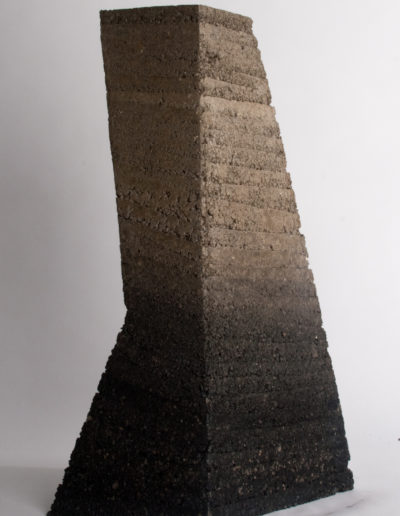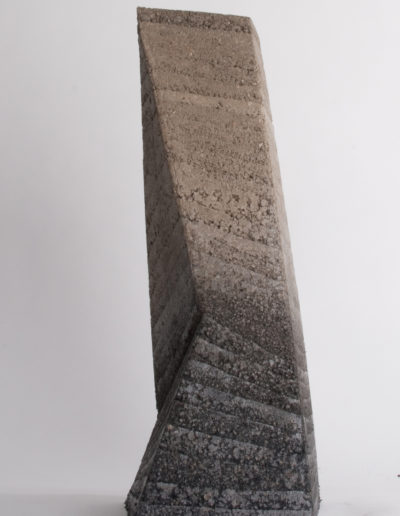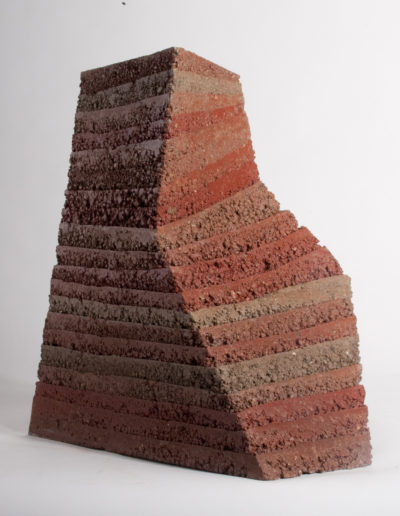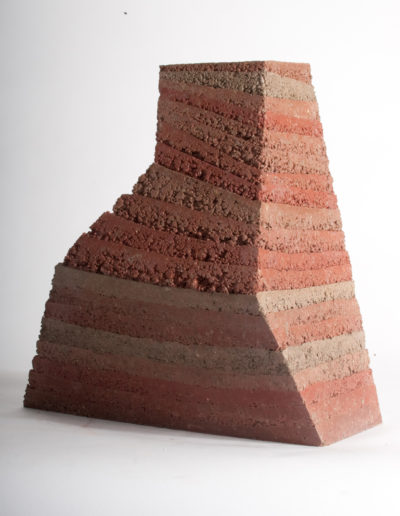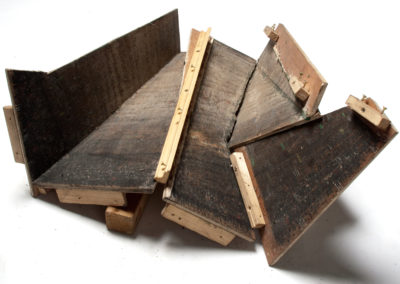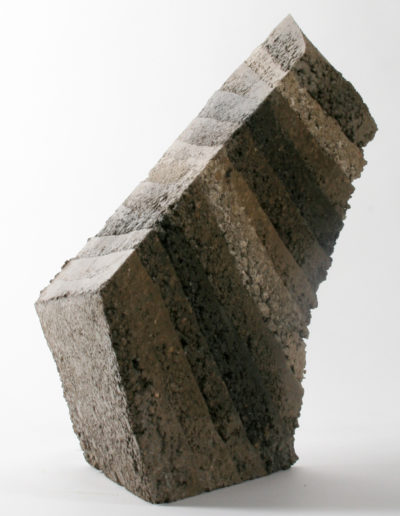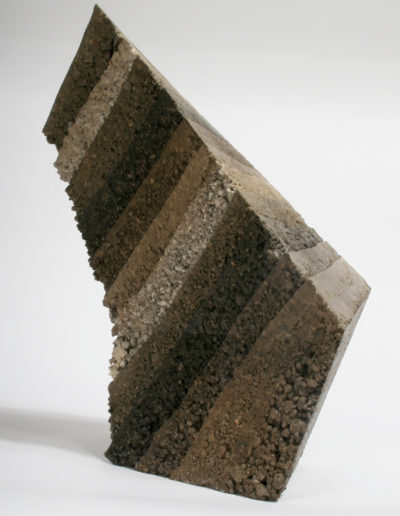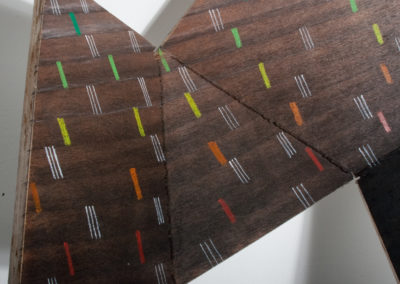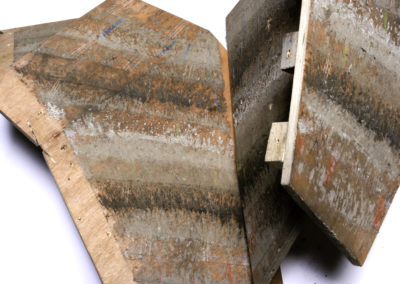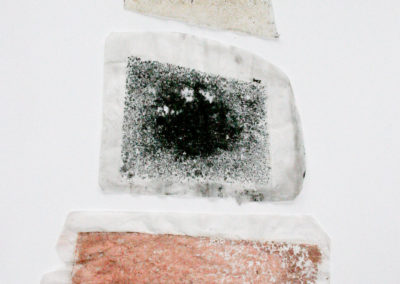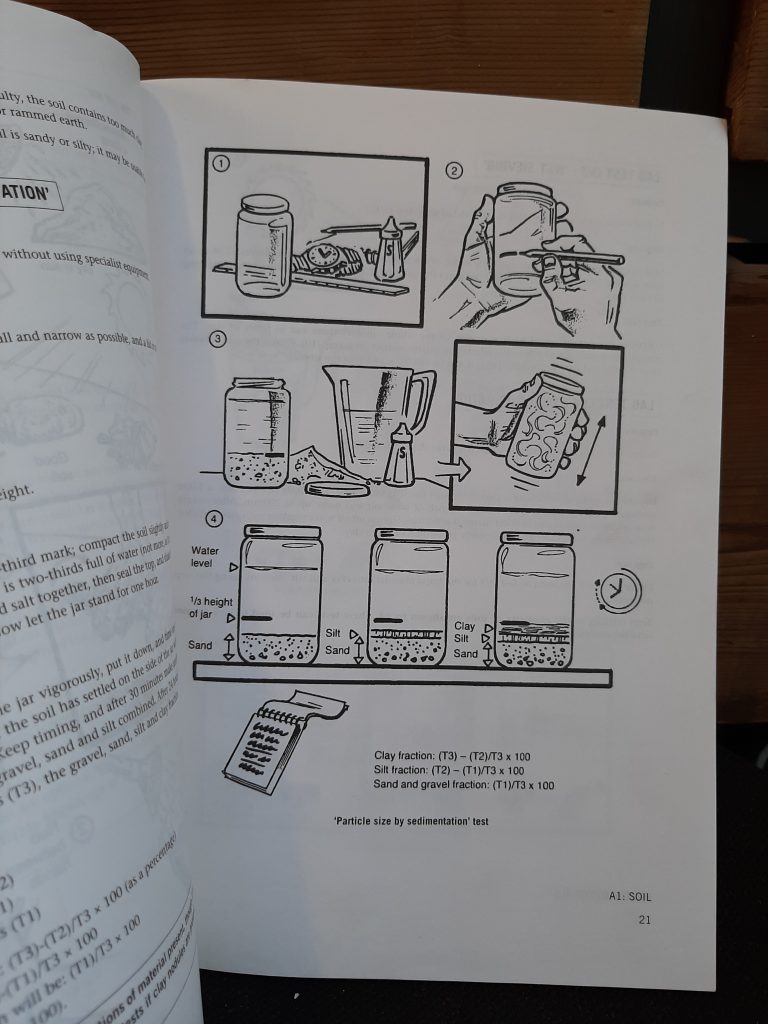Those who contemplate the beauty of the earth find reserves of strength that will endure as long as life lasts. There is something infinitely healing in the repeated refrains of nature – the assurance that dawn comes after night, and spring after winter. -Rachel Carson
In her influential book Silent Spring (1962), Rachel Carson charted the destruction of the careful balance of nature by large-scale and indiscriminate use of pesticides. Toxic poisons such as DDT have since been banned. However human ingenuity creates thousands of new chemicals each year. From flame retardants to medicines, tarmac sealants to cosmetics, this Pandora’s box of new chemicals is astounding and often lifesaving. But the rate of their introduction doesn’t allow time for earth’s ecosystems to adjust and cope with them.
Earth Time and Disruption
Briony Marshall’s new body of rammed earth sculptures alludes to this idea of balance and change. Made using an ancient architectural technique called Rammed Earth, soil and pigment are pounded and compressed into colourful striations in a process akin to the formation of sedimentary rock. The technique has been used for thousands of years across the planet. Recently it has been rediscovered as a green building technique.
If we follow Rachel Carson’s advice and contemplate the amazing beauty that the slow process of evolution has generated on our unique planet, we can’t help but notice an irresolvable clash with the frenetic pace of creativity and change that humans seem to thrive on. Hopefully the solution lies in our own creativity. These sculptures call for us to slow down, contemplate and work to stay in harmony with the steady pace of Earth Time.
Earth Time
Rammed Earth and Carbon Black
47 (h) x 25 x 20cm
Edition 1/3
The paired sculptures Earth Time and Disruption have been made using an ancient architectural technique called Rammed Earth, soil and pigment are pounded and compressed into colourful striations in a process akin to the formation of sedimentary rock. The technique has been used for thousands of years across the planet, but has been rediscovered as an ecological building technique.
Briony Marshall developed the work in response to our increasing reliance on man-made chemicals from flame retardants to medicines, tarmac sealants to cosmetics, this Pandora’s box of new chemicals is astounding and often lifesaving. But the rate of their introduction doesn’t allow time for earth’s ecosystems to adjust and cope with them. To avoid man-made materials, Marshall turned back to earth as her material. Through experimentation, she developed a new sculptural language which manifests layers of time.
Disruption
Rammed Earth and Iron Oxide
25 (h) x 40 x 40cm
Edition 1/3
Oxygen gas first appeared in the earth’s atmosphere around 2.5 billion years ago. It was created by the ancestors of green plants and was poisonous to the vast majority of the bacteria that populated the planet at the time. This was the first great extinction that we know of. But life continued and the surviving organism not only developed coping mechanism but our ancestors then developed a means of using oxygen to release energy from food. There are traces of this Oxygen Catastrophy in rocks: the new Oxygen combined with Iron to form the rust coloured Iron Oxide which was laid down as red streaks in rocks.
To make a work out of earth is a political statement: a rejection of systems of value which has at its heart consumerism and the primacy of first-world human experience over other concerns and agents. This includes a rejection of man-made materials which can cause long term damage to both us and the environment. Yet concerns for making durable ‘safe’ objects that can be sold as art objects in the part of the art world in which I have been operating, led me to include cement in the mix and seal the rammed earth with a synthetic layer. These compromises might lead these works to reach an audience and inspire more people to think about the consequences of their actions, and yet is ironically reminiscent of most attempts to ethical or healthy living – self indulgent and fatally flawed?
Traces of earth
Plywood, wood, traces of earth and pigment
22 (h) x 55 x 45
Unique
Making rammed earth sculptures involves complex form work in plywood. After having been used as containers for ramming earth, these plywood boxes are marked by traces of soil. I have been playing and reconfiguring the walls to create new objects. This process is reminiscent of natural processes of geology or evolution, in which chance accidents and the pressures of environment, cause a gradual movement away from the original formation or organism into something totally novel.
Create Disruption
Plywood with trace of earth and iron oxide
45 (h) x 60 x 18
Unique
Create Disruption is the unfolded and reconfigured plywood box in which the rammed earth work Disruption was made. The striations of the layers now create their own pattern. Thus making a print of things that have happened and then gone. And this is overlaid on the faint trace of the original layer plans.
Cline Limb
Rammed earth, raw umber and plaster
41h x 20w x 23d
Edition 1/3
In her second work developed using this new rammed earth technique, Briony Marshall has investigated the making process and possibilities it opens up. During the making process of Cline Limb the strata of earth were laid down horizontally. But the sculpture has been rotated onto its larger triangular side in the final work. The layers are thus at an angle reminiscent of rock layers deformed by the movements in the earth’s crust.
Make Cline
Mixed media on plywood
69h x 71w x 22d
Unique
Make Cline can be folded up into a plywood box the right dimension to make Cline Limb. A pattern of layers is planned out on its surface, with colour coding which helps to track which layers to fill and ram the earth to.
Make Cline II
Plywood, wood, traces of earth and pigment
23 (h) x 69 x 39
Unique
Making rammed earth sculptures involves complex form work in plywood. After having been used as containers for ramming earth, these plywood boxes are marked by traces of soil. I have been playing and reconfiguring the walls to create new objects. This process is reminiscent of natural processes of geology or evolution, in which chance accidents and the pressures of environment, cause a gradual movement away from the original formation or organism into something totally novel.
Base Prints
Earth on Baking Paper
Unique
Earth Ramming Tools
Earth
Inside Space
Disruption base print video
https://www.instagram.com/p/BZ8_XrGA50u/
Ramming video
https://www.instagram.com/p/BX7pgeWAM4M/
Related blog posts
New body of work made of Rammed Earth
I have been developing a new body of work using rammed earth: The works started as wax maquettes: Which were then scaled up Form work was made of plywood Layers are colour coded The first completed sculpture was Earth Time: I then experimented with adding...


